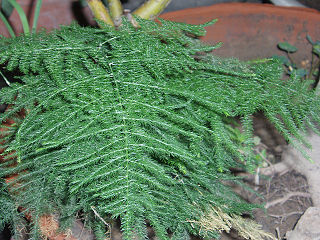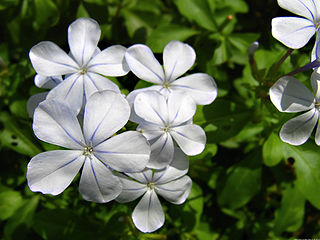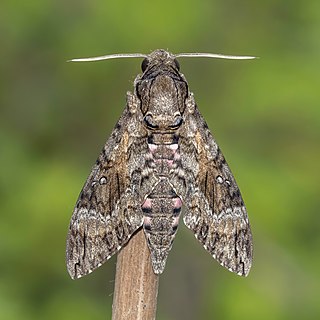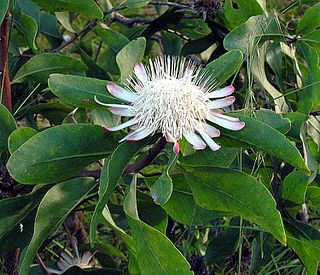
Protea cynaroides, also called the king protea, is a flowering plant. It is a distinctive member of Protea, having the largest flower head in the genus. The species is also known as giant protea, honeypot or king sugar bush. It is widely distributed in the southwestern and southern parts of South Africa in the fynbos region.

Fynbos is a small belt of natural shrubland or heathland vegetation located in the Western Cape and Eastern Cape provinces of South Africa. This area is predominantly coastal and mountainous, with a Mediterranean climate and rainy winters. The fynbos ecoregion is within the Mediterranean forests, woodlands, and scrub biome. In fields related to biogeography, fynbos is known for its exceptional degree of biodiversity and endemism, consisting of about 80% species of the Cape floral kingdom, where nearly 6,000 of them are endemic. This land continues to face severe human-caused threats, but due to the many economic uses of the fynbos, conservation efforts are being made to help restore it.

Asparagus is a genus of flowering plants in the family Asparagaceae, subfamily Asparagoideae. It comprises up to 300 species. Most are evergreen long-lived perennial plants growing from the understory as lianas, bushes or climbing plants. The best-known species is the edible Asparagus officinalis, commonly referred to as just asparagus. Some other members of the genus, such as Asparagus densiflorus, are grown as ornamental plants.

Acacia saligna, commonly known by various names including coojong, golden wreath wattle, orange wattle, blue-leafed wattle, Western Australian golden wattle, and, in Africa, Port Jackson willow, is a small tree in the family Fabaceae. Native to Australia, it is widely distributed throughout the south west corner of Western Australia, extending north as far as the Murchison River, and east to Israelite Bay. The Noongar peoples know the tree as Cujong.

Plumbago is a genus of 23 species of flowering plants in the family Plumbaginaceae, native to warm temperate to tropical regions of the world. Common names include plumbago and leadwort.

Agrius cingulata, the pink-spotted hawkmoth or sweetpotato hornworm, is a moth in the family Sphingidae. The species was first described by Johan Christian Fabricius in 1775.

Hermann Wilhelm Rudolf Marloth was a German-born South African botanist, pharmacist and analytical chemist, best known for his Flora of South Africa which appeared in six superbly illustrated volumes between 1913 and 1932. This botanist is denoted by the author abbreviation Marloth when citing a botanical name.

Cymbalaria muralis, commonly called ivy-leaved toadflax, is a low, spreading, trailing plant with small purple flowers, native to rocky habitats in southern Europe. It belongs to the plantain family (Plantaginaceae), and is introduced and naturalised in many other temperate locations. The flower stalk is unusual for seeking light until it is fertilized, after which it grows away from the light. Other names include coliseum ivy, Kenilworth ivy, mother of thousands, Oxford ivy, and wandering sailor.

Protea eximia, the broad-leaved sugarbush, is a shrub from South Africa that may become a small tree. It occurs in mountain fynbos on mainly mildly acidic sandy soils; the species was very well known under its old name of Protea latifolia. The flowers have awns that are covered in purple-black velvety hairs, and are contained within a series of rings of involucral bracts that have the appearance of petals. The fruit is a densely hairy nut, many of which are inserted on a woody base. The flowers are borne terminally on long shoots, and have a tendency to become very untidy as they age.

Protea gaguedi is a species of tree which belongs to the genus Protea.

Moraea aristata is a species of flowering plant in the family Iridaceae. It is referred to by the common names blue-eyed uintjie or Blouooguintjie in Afrikaans.It is endemic to the city of Cape Town and is considered to be critically endangered.

Swartland Shale Renosterveld is a critically endangered vegetation type of the Western Cape, South Africa.

Elaeodendron melanocarpum is a species of shrubs or small trees endemic to northern Australia. The natural range extends from The Kimberley across The Top End to Cape York Peninsula and southwards to South East Queensland. The species occurs in monsoon forest and drier types of rainforests, commonly along streams.

Gladiolus alatus is a species of geophyte from South Africa. Common names include painted ladies, king kalkoentjie and kipkippie. Kalkoentjie means "little turkey" in Afrikaans and refers to the shape of the flower, which resembles a turkey's wattle. It is popular as a garden plant and an important part of the cut flower industry in parts of the world on account of its large and showy orange flowers.

Aloe speciosa is a species of flowering plant in the Asphodelaceae family. It is commonly called tilt-head aloe and is an arborescent aloe indigenous to the thicket vegetation of the southern Cape Provinces of South Africa.

Grevillea fistulosa, commonly known as Barrens grevillea or Mount Barren grevillea, is a species of flowering plant in the family Proteaceae and is endemic to the Fitzgerald River National Park in the south-west of Western Australia. It is an erect shrub with narrowly egg-shaped to broadly linear leaves and clusters of orange-red to scarlet flowers.

Romulea monadelpha is a herbaceous perennial geophyte in the family Iridaceae native to South Africa. It has a small corm in the soil, a few thread-like leaves, and trimerous dark red flowers with elaborate markings on the inside near the bottom of the flower. It is called karoo satynblom in Afrikaans.

Bergbambostessellata is a bamboo native to the south-eastern highlands of South Africa and Lesotho. It is the sole species in the monotypic genus Bergbambos, belonging to the family Poaceae.

Montinia is a monotypic genus of flowering plants belonging to the family Montiniaceae. It only contains one known species, Montinia caryophyllaceaThunb.

Pavonia praemorsa, commonly referred to as yellow mallow, and sometimes as yellow pavonia, shell flower, and butter bits, is a species of flowering shrub in the mallow family. It is native to the southern coast of South Africa, and produces bright yellow flowers, which bloom and die over the course of a single day. It is drought-resistant and can survive low temperatures, despite mainly growing in the subtropics. Its flowers are also attractive to multiple pollinators.





















